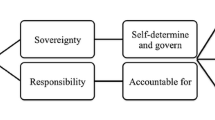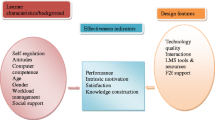Abstract
Competence in collaboration is one of the critical abilities that interior design majors are expected to develop during the course of their education; however, few students are competent to collaborate with others online. The purposes of this study were to identify student perceptions and performance in online collaboration compared to those of offline collaboration and to explore the way students collaborate online. A total of 29 junior interior design students participated in the study. After finishing each online and offline collaborative project, they completed a survey. The findings show that students are more satisfied with offline collaboration and perceive offline collaboration as more effective than online collaboration; however, no significant difference was apparent in student performance online and offline. In addition, the findings show the need to provide appropriate online interface for design collaborations. This paper includes lessons learned and recommendations to promote both online and offline collaboration in a design studio.

Similar content being viewed by others
References
Atack, L. (2003). Becoming a web-based learner: Registered nurses’ experiences. Journal of Advanced Nursing, 44(3), 289–297.
Brandt, C. B., Cennamo, K., Douglas, S., Vernon, M., & McGrath, M. (2011). A theoretical framework for the studio as a learning environment. International Journal of Technology and Design Education,. doi:10.1007/s10798-011-9181-5.
Bunch, M. A. (1993). Core curriculum in architectural education. San Francisco, CA: Mellen Research University Press.
Chen, W., & You, M. (2010). Student response to an internet-mediated industrial design studio course. International Journal of Technology and Design Education, 20, 151–174.
Correia, A. P., & Baran, E. (2010). Lessons learned on facilitating asynchronous discussions for online learning. Educação, Formação & Tecnologias-ISSN 1646-933X, 3(1), 59–67.
Council for Interior Design Accreditation (CIDA). (2011). Professional standards 2011. Retrieved April 13, 2013. http://accredit-id.org/wp-content/uploads/Policy/Professional%20Standards%202011.pdf.
Cuff, D. (1992). Architecture: The story of practice. Cambridge, MA: Massachusetts Institute of Technology Press.
DiDonato, N. C. (2013). Effective self- and co-regulation in collaborative learning groups: An analysis of how students regulate problem solving of authentic interdisciplinary tasks. Instructional Science, 41(1), 25–47.
Dunn, M. (2013). Embracing social media technology in the design studio. Paper presented at the IDEC Annual Conference. Retrieved October 30, 2013, http://2013.idec.org/2012/05/01/embracing-social-media-technology-in-the-desi/.
Facebook. Retrieved from https://www.facebook.com/.
Feichtner, S. B., & Davis, E. A. (1984). Why some groups fail: A survey of students’ experiences with learning groups. Journal of Management Education, 9(4), 58–73.
Girasoli, A. J., & Hannafin, R. D. (2008). Using asynchronous AV communication tools to increase academic self-efficacy. Computers & Education, 51(4), 1676–1682.
GoVisually. Retrieved from http://www.govisually.com/.
Haythornthwaite, C. (2006). Facilitating collaboration in online learning. Journal of Asynchronous Learning Networks, 10(1), 7–24.
Hennessy, S., & Murphy, P. (1999). The potential for collaborative problem solving in design and technology. International Journal of Technology and Design Education, 9(1), 1–36.
Hew, K. F., & Cheung, W. S. (2013). Audio-based versus text-based asynchronous online discussion: Two case studies. Instructional Sciences, 41(2), 365–380. doi:10.1007/s11251-012-9232-7.
Meneely, J., & Portillo, M. (2005). The adaptable mind in design: Relating personality, cognitive style, and creative performance. Creativity Research Journal, 17(2–3), 155–166.
Meyers, L. S., Gamst, G., & Guarino, A. J. (2006). Applied multivariate research: Design and interpretation. Thousand Oaks, CA: Sage.
Morgan, G. A., Leech, N. L., Gloeckner, G. W., & Barrett, K. C. (2004). SPSS for introductory statistics: Use and interpretation (2nd ed.). Mahwah, NJ: LEA.
Mural.ly. Retrieved from https://mural.ly.
Murphy, P., & Hennessy, S. (2001). Realising the potential—and lost opportunities—for peer collaboration in a D&T setting. International Journal of Technology and Design Education, 11(3), 203–237.
Pektas, S. T., & Erkip, F. (2006). Attitudes of design students toward computer usage in design. International Journal of Technology and Design Education, 16(1), 79–95.
Pinterest. Retrieved from https://www.pinterest.com/.
Pintrich, P. R., Smith, D. A. F., Garcia, T., & McKeachie, W. J. (1993). Reliability and predictive validity of the motivated strategies for learning questions (MSLQ). Educational and Psychological Measurement, 53(3), 801–813.
Sagun, A., & Demirkan, H. (2009). On-line critiques in collaborative design studio. International Journal of Technology and Design Education, 19(1), 79–99.
Schön, D. A. (1984). The architectural studio as an exemplar of education for reflection-in-action. Journal of Architectural Education, 38(1), 2–9.
Seitamaa-Hakkarainen, P., Raunio, A.-M., Raami, A., Muukkonen, H., & Hakkarainen, K. (2001). Computer-support for collaborative designing. International Journal of Technology and Design Education, 11(2), 181–202.
Skylar, A. A. (2009). A comparison of asynchronous online text-based lectures with synchronous interactive web conferencing lectures. Issues in Teacher education, 18(2), 69–84.
Webb, J., & Miller, N. (2006). Some preparation required: The journey to successful studio collaboration. Journal of Interior Design, 31(2), 1–9.
Author information
Authors and Affiliations
Corresponding author
Rights and permissions
About this article
Cite this article
Cho, J.Y., Cho, MH. Student perceptions and performance in online and offline collaboration in an interior design studio. Int J Technol Des Educ 24, 473–491 (2014). https://doi.org/10.1007/s10798-014-9265-0
Accepted:
Published:
Issue Date:
DOI: https://doi.org/10.1007/s10798-014-9265-0




